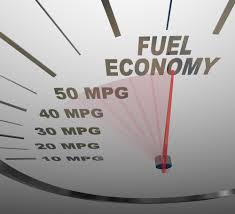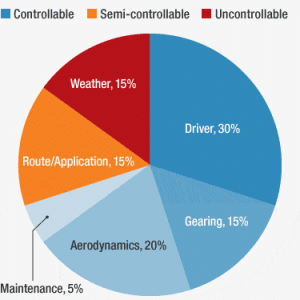Cut Back on Fuel Costs by Finding The Best RPM for Your Engine
When it comes to reducing fuel costs, there’s nothing sweeter than your engine’s sweet spot. Watching your tachometer more closely can help you drive in that sweet spot — the RPM where your engine runs most efficiently.
 You cannot overstate the importance of improving fuel economy because fuel is your highest variable expense. Fuel costs typically “spend off” 45%-55% of your gross revenue. Everything you do to make incremental improvements in consumption has a direct bearing on your bottom line. Taken together, those improvements can add up to significant savings over time. Consider this:
You cannot overstate the importance of improving fuel economy because fuel is your highest variable expense. Fuel costs typically “spend off” 45%-55% of your gross revenue. Everything you do to make incremental improvements in consumption has a direct bearing on your bottom line. Taken together, those improvements can add up to significant savings over time. Consider this:
- The average truck owner-operator travels 120,000 miles each year.
- If you get 8 mpg, you’ll use 15,000 gallons of fuel.
- If you get 6 mpg, you’ll use 20,000 gallons of fuel.
- Even with fluctuations in fuel costs, that’s about a $20,000 difference – certainly enough warrant doing everything you can to improve your mileage.
Torque trumps horsepower.
There’s no doubt that reducing your speed can help conserve fuel, up to a point. But getting the most from every drop is more complex than simply applying a lighter foot. Other factors affect your fuel consumption, especially the terrain over which you travel and the weight of your load.
Using your truck’s horsepower to muscle your way through steep terrain wastes fuel and causes undue wear and tear on your vehicle and engine. Strategically using torque instead accomplishes the same goal more easily because it’s a better use of your engine’s energy. You won’t have to shift so often, which means you’re saving your own energy as well. Less stress and fatigue at the end of the day for you and your rig. Torque improves your ability to tow heavy loads at speed, too.
So where, exactly, is your engine’s sweet spot? In general, it’s in the range of 1250-1350 RPM, but it varies for each engine. You should never exceed 1500 RPM. We can tell you the officially-designated peak horsepower and peak torque for your engine to help identify your sweet spot.
Driving for fuel efficiency.
 If you’re an owner-operator, you are intimately familiar with driving-related costs and the need to control them wherever possible. If you’re a driver for a fleet, you may not have given much thought to how your behind-the-wheel behaviors affect your company’s bottom line. But you should. Helping them make a profit makes you a stronger asset. And the company’s
If you’re an owner-operator, you are intimately familiar with driving-related costs and the need to control them wherever possible. If you’re a driver for a fleet, you may not have given much thought to how your behind-the-wheel behaviors affect your company’s bottom line. But you should. Helping them make a profit makes you a stronger asset. And the company’s
good financial health benefits you, too.
Little things like tire pressure can make a noticeable difference in fuel consumption, and those little things add up.
Cut down on idling time. It burns about one gallon of fuel every hour. If you usually idle for several hours overnight, take a few minutes to compare the fuel (and wear-related) cost of doing that against alternatives such as motel rooms, acquiring an Auxiliary Power Unit (APU) or using shore power. Installing an APU can run around $9000, but a typical unit burns 0.2 gallons per hour. If you use it enough, you could be money ahead in the long run.
Use progressive shifting. Maintaining your engine’s sweet spot under very heavy loads or in especially hilly terrain requires different shifting and throttle patterns. And if you have a boost gauge, keep it as low as possible so you’re not wasting engine power.
Driving behaviors that help reduce fuel costs also help you reduce vehicle maintenance frequency and costs and extend the life of brakes, tires and other wearable components. You’re saving on multiple fronts.
You’ve invested a lot of money in your rig. Shouldn’t you do everything you can to help it perform better and last longer? When you watch your RPMs to maintain the most efficient torque, you will reduce fuel costs. And that’s sure to sweeten your bottom line.
